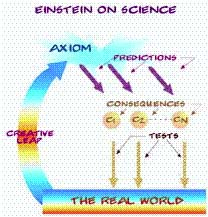

| The Three Cosmic Cats of Einstein In 1955, a few years before his death, Albert Einstein received a letter from Maurice Solovine, a lifelong friend. Although Solovine was not a scientist, he apparently enjoyed discussing science with the noted physicist. In the letter, Solovine expressed that he had trouble understanding something that Einstein had written in an earlier essay. Einstein's reply began with an apology to his friend for the confusion, which was brought about by Solovine's misunderstanding of the structure of science. | |
| Einstein blamed himself for never having explained it carefully. To illustrate his explanation, Einstein included a sketch (recreated to the right). In the text of the letter, Einstein explained the gap--the empty space--which must be bridged by the creative leap anybody takes in attempting to explain a phenomenon. This leap, while intuitive and often insightful, is not necessarily scientific. |  |
| The scientific "process" begins when the scientist takes the axiom and predicts consequences based on it. The process demands that these predictions be tested against the "real" world. The axiom is (scientifically) worthless if there is no match between the predicted consequences and the tests or experiments. Correlation between predictions and tests indicate the idea or axiom might have merit. The scientific community is brought into the process when the axiom or idea is published, and often the original work is modified. From The Creative Leap by Gerald F. Wheeler, Quantum Magazine,January/February 1997 A Footnote on the Universal Search for a Simpler Mouser | |
-28-
copyright © 1997, MG Taylor Corporation (except where noted)
copyrights, terms and conditions